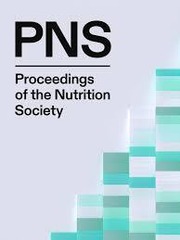Crossref Citations
This article has been cited by the following publications. This list is generated based on data provided by
Crossref.
Demigné, Christian
Sabboh, Houda
Rémésy, Christian
and
Meneton, Pierre
2004.
Protective Effects of High Dietary Potassium: Nutritional and Metabolic Aspects.
The Journal of Nutrition,
Vol. 134,
Issue. 11,
p.
2903.
Spanghero, M
2004.
Prediction of urinary and blood pH in non-lactating dairy cows fed anionic diets.
Animal Feed Science and Technology,
Vol. 116,
Issue. 1-2,
p.
83.
MacLeay, J.M.
Olson, J.D.
Enns, R.M.
Les, C.M.
Toth, C.A.
Wheeler, D.L.
and
Turner, A.S.
2004.
Dietary-Induced Metabolic Acidosis Decreases Bone Mineral Density in Mature Ovariectomized Ewes.
Calcified Tissue International,
Vol. 75,
Issue. 5,
p.
431.
Roosen, Alexander
Gerharz, Elmar W.
Roth, Stefan
and
Woodhouse, Christopher R. J.
2004.
Bladder, bowel and bones?skeletal changes after intestinal urinary diversion.
World Journal of Urology,
Vol. 22,
Issue. 3,
p.
200.
Zwart, Sara R
Hargens, Alan R
and
Smith, Scott M
2004.
The ratio of animal protein intake to potassium intake is a predictor of bone resorption in space flight analogues and in ambulatory subjects.
The American Journal of Clinical Nutrition,
Vol. 80,
Issue. 4,
p.
1058.
Sarko, John
2005.
Bone and Mineral Metabolism.
Emergency Medicine Clinics of North America,
Vol. 23,
Issue. 3,
p.
703.
Jahr, Holger
van Driel, Marjolein
van Osch, Gerjo J.V.M.
Weinans, Harrie
and
van Leeuwen, Johannes P.T.M.
2005.
Identification of acid-sensing ion channels in bone.
Biochemical and Biophysical Research Communications,
Vol. 337,
Issue. 1,
p.
349.
Macdonald, Helen M
New, Susan A
Fraser, William D
Campbell, Marion K
and
Reid, David M
2005.
Low dietary potassium intakes and high dietary estimates of net endogenous acid production are associated with low bone mineral density in premenopausal women and increased markers of bone resorption in postmenopausal women.
The American Journal of Clinical Nutrition,
Vol. 81,
Issue. 4,
p.
923.
Bonjour, Jean-Philippe
2005.
Dietary Protein: An Essential Nutrient For Bone Health.
Journal of the American College of Nutrition,
Vol. 24,
Issue. sup6,
p.
526S.
Brandao-Burch, A.
Utting, J. C.
Orriss, I. R.
and
Arnett, T. R.
2005.
Acidosis Inhibits Bone Formation by Osteoblasts In Vitro by Preventing Mineralization.
Calcified Tissue International,
Vol. 77,
Issue. 3,
p.
167.
Komarova, Svetlana V.
Pereverzev, Alexey
Shum, Jonathan W.
Sims, Stephen M.
and
Dixon, S. Jeffrey
2005.
Convergent signaling by acidosis and receptor activator of NF-κB ligand (RANKL) on the calcium/calcineurin/NFAT pathway in osteoclasts.
Proceedings of the National Academy of Sciences,
Vol. 102,
Issue. 7,
p.
2643.
SEUWEN, KLAUS
LUDWIG, MARIE-GABRIELLE
and
WOLF, ROMAIN M.
2006.
Receptors for Protons or Lipid Messengers or Both?.
Journal of Receptors and Signal Transduction,
Vol. 26,
Issue. 5-6,
p.
599.
Abraham, R.
Walton, J.
Russell, L.
Wolman, R.
Wardley-Smith, B.
Green, J. R.
Mitchell, A.
and
Reeve, J.
2006.
Dietary determinants of post-menopausal bone loss at the lumbar spine: a possible beneficial effect of iron.
Osteoporosis International,
Vol. 17,
Issue. 8,
p.
1165.
Zwart, S. R.
Watts, S. M.
Sams, C. F.
Whitson, P. A.
and
Smith, S. M.
2006.
Reducing Dietary Acid Load as a Potential Countermeasure for Bone Loss Associated with Spaceflight.
Dayer, Romain
Rizzoli, René
Kaelin, André
and
Ammann, Patrick
2006.
Low Protein Intake Is Associated With Impaired Titanium Implant Osseointegration.
Journal of Bone and Mineral Research,
Vol. 21,
Issue. 2,
p.
258.
Yerramshetty, Janardhan S.
Lind, Cora
and
Akkus, Ozan
2006.
The compositional and physicochemical homogeneity of male femoral cortex increases after the sixth decade.
Bone,
Vol. 39,
Issue. 6,
p.
1236.
Haynes, David R.
and
Findlay, David M.
2006.
Wiley Encyclopedia of Biomedical Engineering.
Smit, T. H.
Krijnen, M. R.
van Dijk, M.
and
Wuisman, P. I. J. M.
2006.
Application of polylactides in spinal cages: Studies in a goat model.
Journal of Materials Science: Materials in Medicine,
Vol. 17,
Issue. 12,
p.
1237.
Muzylak, M.
Price, J. S.
and
Horton, M. A.
2006.
Hypoxia Induces Giant Osteoclast Formation and Extensive Bone Resorption in the Cat.
Calcified Tissue International,
Vol. 79,
Issue. 5,
p.
301.
Link, Dennis P.
van den Dolder, Juliette
Jurgens, Wouter J.F.M.
Wolke, Joop G.C.
and
Jansen, John A.
2006.
Mechanical evaluation of implanted calcium phosphate cement incorporated with PLGA microparticles.
Biomaterials,
Vol. 27,
Issue. 28,
p.
4941.

